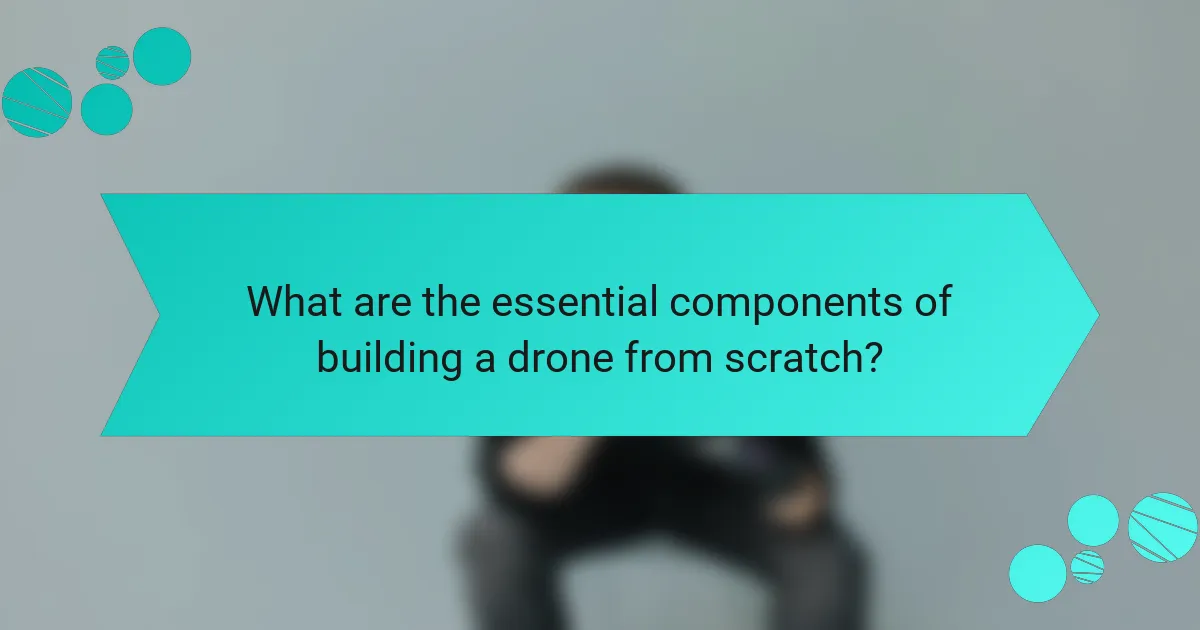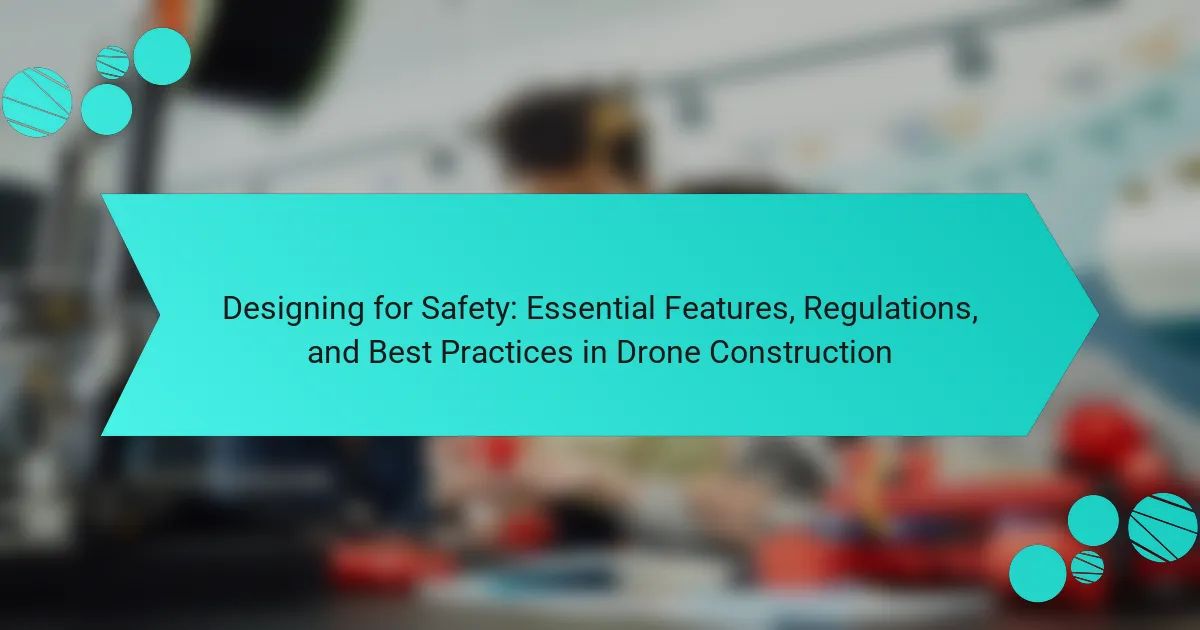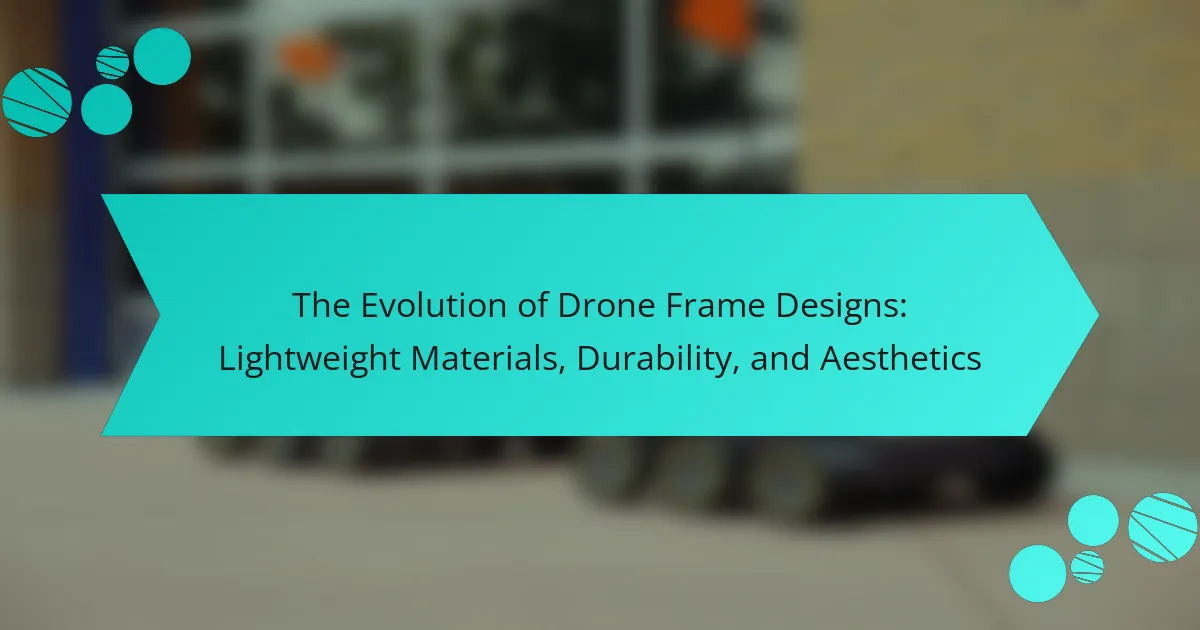
What are the essential components of building a drone from scratch?
The essential components of building a drone from scratch include the frame, motors, electronic speed controllers (ESCs), flight controller, battery, and propellers. The frame serves as the structure that holds all components together. Motors provide the necessary thrust to lift the drone. ESCs regulate the power to the motors and control their speed. The flight controller is the brain of the drone, processing inputs from various sensors to stabilize flight. The battery supplies power to all electronic components. Propellers generate lift and are crucial for flight dynamics. Each component plays a vital role in ensuring the drone operates effectively.
How do each of these components contribute to the drone’s functionality?
The components of a drone significantly enhance its functionality. The frame provides structural integrity and supports other components. The motors generate lift and control movement. Propellers convert motor power into thrust, enabling flight. The flight controller processes data from sensors to stabilize the drone. The battery supplies power to all components, determining flight time. The GPS module aids in navigation and positioning. Sensors like cameras and ultrasonic devices enhance functionality by providing data for specific tasks. Each component works collaboratively to ensure the drone operates effectively and efficiently.
What is the role of the frame in a drone?
The frame in a drone serves as its structural backbone. It supports all other components, including motors, flight controllers, and batteries. The frame’s design influences the drone’s weight, stability, and aerodynamics. A lightweight frame enhances flight efficiency. Materials like carbon fiber or plastic are commonly used for durability and weight reduction. The frame also determines the drone’s size and shape, affecting maneuverability. Proper frame design is crucial for optimal performance and handling. Overall, the frame is essential for ensuring the drone’s functionality and longevity.
How do motors and propellers affect drone performance?
Motors and propellers significantly influence drone performance. Motors determine the thrust and speed, while propellers affect lift and efficiency. Higher RPM motors can increase speed but may decrease battery life. The size and pitch of propellers also impact how much lift is generated. Larger propellers typically provide more lift but require more power. Conversely, smaller propellers may enhance maneuverability but reduce maximum lift capacity. The combination of motor power and propeller design must be optimized for the intended flight conditions. Research shows that the right motor-propeller pairing can improve flight time by up to 20%. This optimization is crucial for achieving desired performance metrics in drone applications.
What is the significance of the flight controller?
The flight controller is crucial for drone operation. It serves as the brain of the drone, processing data from various sensors. This includes accelerometers, gyroscopes, and GPS units. The flight controller maintains stability and controls the drone’s movements. It interprets pilot commands and adjusts the motors accordingly. This ensures precise maneuverability and responsiveness. Flight controllers also enable autonomous flight modes. These modes enhance functionality for tasks like aerial photography or surveying. Overall, the flight controller is essential for safe and efficient drone flight.
How does battery selection impact flight time and efficiency?
Battery selection directly affects a drone’s flight time and efficiency. The capacity of the battery, measured in milliamp hours (mAh), determines how long the drone can operate before needing a recharge. A higher mAh rating typically allows for longer flight durations.
Additionally, the weight of the battery impacts efficiency. Heavier batteries can reduce flight time due to increased energy consumption. The type of battery, such as lithium polymer (LiPo) or lithium-ion, also influences performance. LiPo batteries generally provide higher discharge rates, enhancing thrust and efficiency during flight.
Moreover, battery voltage affects the power output. A higher voltage battery can improve motor performance, leading to increased speed and agility. Selecting the right battery ensures optimal balance between weight, capacity, and power, directly influencing the drone’s overall performance.
What tools are required for building a drone from scratch?
To build a drone from scratch, several essential tools are required. A soldering iron is needed for connecting electronic components. Wire strippers help in preparing wires for connections. A multimeter is necessary for testing electrical connections and ensuring functionality. A screwdriver set allows for assembling the drone frame and securing components. Pliers are useful for bending and cutting wires. A heat shrink tubing kit provides insulation for soldered connections. Finally, a computer with appropriate software is needed for configuring the drone’s flight controller. These tools collectively enable the successful assembly of a functional drone.
Which basic tools do beginners need to start building drones?
Beginners need a few essential tools to start building drones. A soldering iron is crucial for connecting electronic components. Wire cutters and strippers are necessary for preparing wires. A small screwdriver set helps with assembling parts securely. A heat shrink tubing kit is important for insulating soldered connections. A multimeter allows for checking electrical connections and battery voltage. Finally, a hobby knife is useful for precise cutting of materials. These tools collectively facilitate the assembly and troubleshooting of drone components effectively.
What advanced tools can enhance the building process?
Advanced tools that can enhance the building process of a drone include 3D printers, CNC machines, and advanced soldering stations. 3D printers allow for the precise creation of custom parts and components. CNC machines provide high accuracy in cutting and shaping materials. Advanced soldering stations enable efficient and reliable connections of electronic components. These tools improve efficiency and accuracy during assembly. They also reduce the need for manual labor, streamlining the building process. The integration of these technologies is critical for achieving high-quality results in drone construction.

What are the best practices for assembling a drone?
The best practices for assembling a drone include careful planning, organization, and attention to detail. Start by gathering all necessary components and tools. Ensure that you have the frame, motors, propellers, flight controller, battery, and transmitter. Organize these parts to avoid confusion during assembly. Follow the manufacturer’s instructions closely for each component. Securely attach the motors to the frame using the appropriate screws. Connect the flight controller to the motors and power distribution board accurately. Ensure all wiring is neat to prevent interference and damage. Calibrate the drone’s settings according to the manufacturer’s guidelines before the first flight. Test all systems thoroughly to confirm functionality. These practices help ensure a successful assembly and safe operation of the drone.
How can you ensure a successful assembly process?
To ensure a successful assembly process, follow a structured approach. Begin by organizing all components and tools required for assembly. This includes motors, frames, batteries, and wiring. Next, refer to a detailed assembly guide specific to the drone model. Such guides often include step-by-step instructions. Pay attention to the orientation of components during installation. Incorrect placement can lead to malfunctions. Additionally, double-check all connections for security and proper fit. Loose connections can hinder performance. Testing the assembled drone before finalizing is crucial. This helps identify any issues early on. Following these steps can significantly enhance the likelihood of a successful assembly.
What steps should be followed during the assembly of drone components?
Begin by gathering all necessary components. This includes the frame, motors, electronic speed controllers, flight controller, and battery. Next, attach the motors to the frame securely. Ensure that each motor is oriented correctly for optimal flight performance. Then, connect the electronic speed controllers to the motors and secure them to the frame. After that, install the flight controller in a central location on the frame. Connect the flight controller to the electronic speed controllers and ensure all wiring is neat. Finally, attach the battery to the frame and connect it to the flight controller. Double-check all connections for safety and functionality before powering on the drone.
How do you troubleshoot common assembly issues?
To troubleshoot common assembly issues, start by identifying the specific problem. Check for misaligned parts, as this can prevent proper assembly. Ensure that all screws and fasteners are tightened correctly. Inspect wiring connections for any loose or disconnected components. Verify that the correct components are being used according to the assembly instructions. If parts do not fit together, consult the manual for guidance on orientation. Use a multimeter to test electrical connections if the drone does not power on. These steps can help resolve many common assembly problems effectively.
What safety precautions should be taken while building a drone?
Safety precautions while building a drone include wearing protective eyewear. This prevents eye injuries from small parts or tools. Using a well-ventilated workspace is essential to avoid inhaling fumes from soldering or adhesives. Keeping a fire extinguisher nearby is advisable, especially when working with batteries. Ensuring all tools are in good condition prevents accidents during assembly. Following manufacturer guidelines for battery handling reduces the risk of explosions or fires. Lastly, securing loose clothing and hair keeps them away from moving parts. These precautions help ensure a safe building experience.
What personal protective equipment is recommended?
Recommended personal protective equipment (PPE) includes safety goggles, gloves, and a dust mask. Safety goggles protect the eyes from debris and particles during assembly. Gloves prevent cuts and abrasions when handling sharp components. A dust mask safeguards against inhaling fine dust or fumes from materials. Using this PPE reduces the risk of injury while building a drone. According to the Occupational Safety and Health Administration (OSHA), proper PPE significantly decreases workplace hazards.
How can you safely handle electronic components?
To safely handle electronic components, always discharge static electricity before touching them. This can be done by grounding yourself using an anti-static wrist strap or touching a grounded metal object. Use anti-static mats to provide a safe working surface. Handle components by their edges to avoid touching sensitive parts. Keep components in anti-static bags when not in use to prevent damage. Avoid working in humid environments, as moisture can cause short circuits. Ensure your workspace is clean and organized to prevent accidental damage or loss of components. Follow these practices to minimize the risk of damaging electronic components during assembly.

What tips can improve your drone building experience?
To improve your drone building experience, start with thorough research on components. Understanding each part’s function enhances assembly efficiency. Gather all necessary tools before beginning. This prevents interruptions during the build process. Follow a step-by-step guide tailored for your specific drone model. This ensures you do not overlook critical steps. Label and organize your components to avoid confusion. This practice saves time and reduces errors. Test each component individually before final assembly. This helps identify issues early. Finally, join online forums or communities for support and advice. Engaging with experienced builders can provide valuable insights and solutions.
How can you optimize the performance of your DIY drone?
To optimize the performance of your DIY drone, focus on enhancing its weight-to-power ratio. Use lightweight materials for the frame, such as carbon fiber or plastic. Select high-efficiency motors that provide more thrust with less power consumption. Ensure the propellers are matched to the motor specifications for optimal lift and efficiency. Calibrate the electronic speed controllers (ESCs) for precise motor control. Additionally, fine-tune the flight controller settings to improve stability and responsiveness. Regularly update firmware for the flight controller to access performance improvements. Conduct test flights to gather data for further adjustments.
What are the best practices for testing your drone after assembly?
Conduct a pre-flight checklist to ensure all components are secure. Check battery connections and ensure they are properly charged. Verify that the propellers are correctly installed and free from damage. Perform a range test to confirm the remote control’s signal strength. Conduct a hover test in a safe, open area to assess stability and control. Monitor for unusual sounds or vibrations during the hover. Test the drone’s flight modes to confirm they respond correctly. Finally, review the drone’s performance data if available, to ensure all systems function as intended.
How can you modify your drone for specific purposes or environments?
You can modify your drone for specific purposes or environments by changing its components and settings. For aerial photography, attach a high-resolution camera and stabilize the gimbal. For racing, use lightweight materials and enhance the speed with powerful motors. To improve battery life, select a larger capacity battery while ensuring it fits the frame. For harsh environments, consider waterproofing the drone and using rugged materials. Adjust the flight controller settings to optimize performance for different conditions. Each modification aligns with the intended use, enhancing functionality and reliability.
What common mistakes should be avoided when building a drone?
Common mistakes to avoid when building a drone include neglecting to research components thoroughly. Choosing incompatible parts can lead to malfunction. Another mistake is overlooking weight distribution, which affects flight stability. Failing to follow wiring diagrams can result in short circuits. Not calibrating the drone properly before the first flight can cause crashes. Ignoring battery specifications may lead to insufficient power or damage. Lastly, skipping safety checks before flying can pose risks to the user and others. These mistakes can significantly impact the drone’s performance and safety.
How can improper wiring affect drone functionality?
Improper wiring can severely compromise drone functionality. It can lead to power failures, causing the drone to crash. Short circuits may occur, damaging electronic components. Incorrect connections can disrupt signal transmission between the transmitter and receiver. This results in poor control and responsiveness. Additionally, overheating can happen, which risks fire hazards. Research shows that over 30% of drone failures are linked to wiring issues. Proper wiring is essential for safe and reliable drone operation.
What are the pitfalls of neglecting weight distribution?
Neglecting weight distribution in drone assembly can lead to significant performance issues. Uneven weight can cause instability during flight. This instability may result in difficulty controlling the drone. Poor weight distribution can also affect battery life and flight duration. A drone that is not balanced may experience increased strain on motors. This strain can lead to premature motor failure. Additionally, improper weight distribution can impact the drone’s ability to carry payloads. Research indicates that a well-balanced drone performs better in terms of maneuverability and efficiency.
Building a drone from scratch involves understanding essential components such as the frame, motors, electronic speed controllers, flight controller, battery, and propellers, each playing a critical role in functionality and performance. The article outlines the tools required for assembly, including basic and advanced options, and provides best practices for ensuring a successful build. It also addresses common mistakes to avoid, the significance of proper wiring and weight distribution, and tips for optimizing drone performance and safety during assembly and testing.



